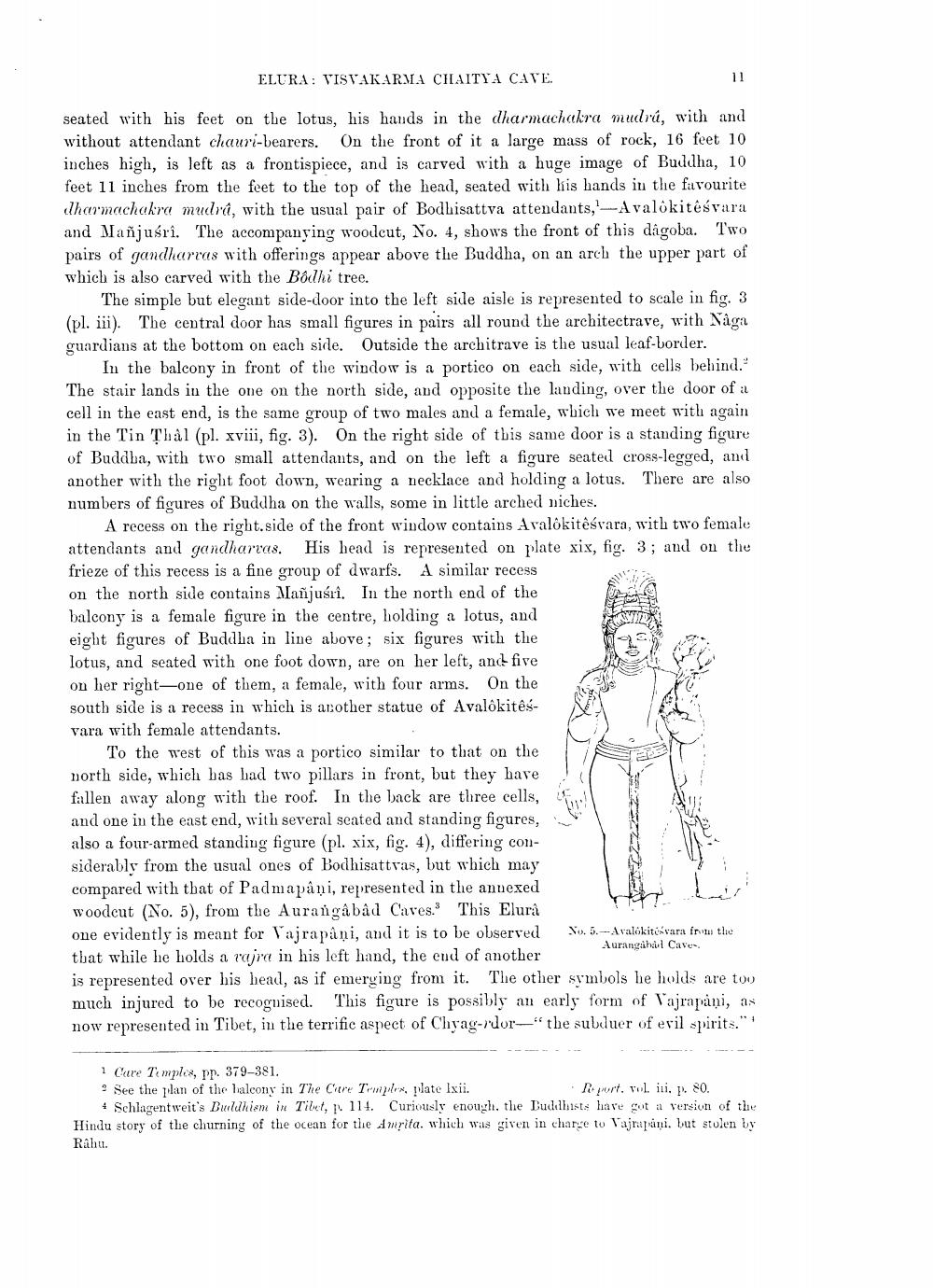________________
ELURA: VISVAKARMA CHAITYA CAVE.
seated with his feet on the lotus, his hands in the dharmachakra mudrů, with and without attendant chauri-bearers. On the front of it a large mass of rock, 16 feet 10 inches high, is left as a frontispiece, and is carved with a huge image of Buddha, 10 feet 11 inches from the feet to the top of the head, seated with his hands in the favourite dharmachakra mudra, with the usual pair of Bodhisattva attendants, Avalokitesvara and Manjusri. The accompanying woodcut, No. 4, shows the front of this dagoba. Two pairs of gandharvas with offerings appear above the Buddha, on an arch the upper part of which is also carved with the Bolhi tree.
The simple but elegant side-door into the left side aisle is represented to scale in fig. 3 (pl. ii). The central door has small figures in pairs all round the architectrave, with Någa guardians at the bottom on each side. Outside the architrave is the usual leaf-border.
In the balcony in front of the window is a portico on each side, with cells behind." The stair lands in the one on the north side, and opposite the landing, over the door of a cell in the east end, is the same group of two males and a female, which we meet with again in the Tin Thal (pl. xviii, fig. 3). On the right side of this same door is a standing figure of Buddha, with two small attendants, and on the left a figure seated cross-legged, and another with the right foot down, wearing a necklace and holding a lotus. There are also numbers of figures of Buddha on the walls, some in little arched niches.
A recess on the right side of the front window contains Avalokitesvara, with two female attendants and gandharras. His head is represented on plate xix, fig. 3; and on the frieze of this recess is a fine group of dwarfs. A similar recess on the north side contains Mañjusri. In the north end of the balcony is a female figure in the centre, holding a lotus, and eight figures of Buddha in line above; six figures with the lotus, and seated with one foot down, are on her left, and five on her right-one of them, a female, with four arms. On the south side is a recess in which is arother statue of Avalokitêsvara with female attendants.
To the west of this was a portico similar to that on the north side, which has had two pillars in front, but they have fallen away along with the roof. In the back are three cells, and one in the east end, with several seated and standing figures, also a four-armed standing figure (pl. xix, fig. 4), differing considerably from the usual ones of Bodhisattvas, but which may compared with that of Padmapâņi, represented in the annexed woodcut (No. 5), from the Aurangabad Caves. This Elurâ one evidently is meant for Vajra påņi, and it is to be observed u. 5. - Avalokito vara from the
Aurangabal Caves that while he holds a vajra in his left hand, the end of another is represented over his head, as if emerying from it. The other symbols he holds are too much injured to be recoguised. This figure is possibly an early form of Vajrapáni, as now represented in Tibet, in the terrific aspect of Chyag-rdor—"the subduer of evil spirits."
1 Cure Temples, pr. 379-381. ? See the plan of the balcony in The Cure Templex, plate Ixii.
Report. vol. ill. 80. 4 Schlagentweit's Buildhism in Tibet, p. 114. Curiously enough, the Luddhists have got a version of the Hindu story of the churning of the ocean for the Amrita. which was given in charge to Vajrapuni. but stolen by Rahu.




